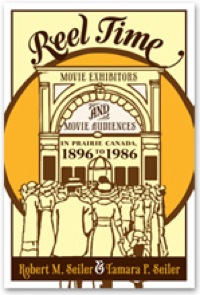Click here to print
Movies on the Canadian Prairie
posted November 26, 2012

Their ambitious project has now borne fruit in their new book, Reel Time: Movie Exhibitors and Movie Audiences in Prairie Canada, 1896 to 1986, from Athabasca University Press.
The two emeritus professors at the University of Calgary – she in Canadian studies, he in communication studies – spent many hours in archives investigating their subject, which was expansive: nothing less than the history of film exhibition in the Canadian Prairie West from the first movie exhibition halls to the digital revolution. They emerged from the archives with a tale of the pivotal role of amusement venues as both a social practice and commercial enterprise that propelled the Canadian Prairie West into modernity, and shaped leisure activities of working- and middle-class people there, as across North America.

 Their Reel Time, they say by email, charts the growth of movie exhibition as a business venture and, by extension, documents the conditions of moviegoing as a social practice in the Canadian prairies, primarily during the heyday of the indoor, single-screen facility. “The book,” they say, “tells the story of those entertainment entrepreneurs who established movie exhibition as a legitimate business in prairie Canada, responded to campaigns to reform the industry, designed safe and comfortable facilities, and founded the national movie theatre chains, namely, Allen Theatre Enterprises, Famous Players, and Odeon Theatres.
Their Reel Time, they say by email, charts the growth of movie exhibition as a business venture and, by extension, documents the conditions of moviegoing as a social practice in the Canadian prairies, primarily during the heyday of the indoor, single-screen facility. “The book,” they say, “tells the story of those entertainment entrepreneurs who established movie exhibition as a legitimate business in prairie Canada, responded to campaigns to reform the industry, designed safe and comfortable facilities, and founded the national movie theatre chains, namely, Allen Theatre Enterprises, Famous Players, and Odeon Theatres.
“Reel Time thus examines such business and social topics as theatre design, programming strategies, seating arrangements, pricing policies, marketing schemes, and expansion, with a view to illuminating the centralizing and standardizing processes at work in the commercialization of public leisure-time activities in general and moviegoing in particular.
“In formulating our project, we took our cue from those scholars who have studied (to cite Gregory A. Waller) how commercial entertainment in various locales or regions has been packaged, promoted, and consumed, especially Robert C. Allen and Douglas Gomery, who challenged researchers to undertake empirical studies of such topics as moviegoing in their own communities. We also employed qualitative as well as quantitative modes or research, including (1) critical political economy, (2) stylistic typology, and (3) discursive analysis.
“Alas, vital materials have disappeared because for a long time people did not take popular entertainment seriously. By the same token, few people left accounts of their moviegoing experience. We therefore cast our net widely, sifting through newspapers and trade journals to uncover information about the movie exhibition business in general and individual entrepreneurs in particular, including when they opened and closed selected facilities. We spent hundreds of hours at microfilm readers, tracking down articles that shed light on movie exhibition and moviegoing. We sifted through city and business directories, which list alphabetically and provide a street-by-street inventory of residences and commercial establishments, plus the names (and the street addresses) of the owners and the managers of movie houses (and, for some periods, distributors and producers). They are thus useful for reconstructing the layout of a business area; public records, such as building permits, fire insurance maps, property tax assessments, building evaluations, and demolition fire reports; corporate records, such as annual statements, reports to stockholders, official (opening) programs, investment circulars, and press releases; architectural plans and building reports; newspapers and motion picture trade papers, which report on the week-by-week operation of movie theatres (and movie theatre chains), in terms of (say) opening day, advertisements for up-and-coming movies, marketing strategies, major renovations, and closing; and local and regional histories, memoirs, interviews, and photographs.
“We visited and/or contacted many archives, with a view to tracking down articles, business records, clippings, memoirs, photographs, and tributes, including the Cinémathèque Québécoise library, Montreal; Library and Archives Canada, Ottawa; the Ontario Jewish Archives, Toronto; the Clara Thomas Archives and Special Collections, Scott Library, York University, Toronto; the provincial Manitoba, Saskatchewan, and Alberta provincial archives; city archives in Winnipeg, Brandon, Regina, Saskatoon, Edmonton, and Calgary; and public libraries in Ottawa,Toronto, Brantford, Winnipeg, Brandon, Regina, Saskatoon, Edmonton, and Calgary. At one time, librarians cut out articles on such topics as entertainment in general and moviegoing in particular, e.g., articles on the opening and the closing of individual movie theatres. These served as a useful point of departure.
“Overall, our experiences with these archives were very positive. The archivists were unfailingly helpful. The major problem we encountered was the paucity of materials on movie going and on the movie exhibition business. We assume, as mentioned above, that this problem reflects the fact that until recently, many aspects of popular culture, including movies, were not regarded as worthy of serious study. Many involved in the exhibition business likely didn’t think of depositing materials with archives, and many archivists likely didn’t make a great effort to collect such material. Another problem area for us was that of archival photographs. Problems included the difficulty of finding appropriate photographs of a quality suitable for digitalization, the difficulty of securing permission to publish photos and, in some cases, the expense involved.”
Printed from Moving Image Archive News: http://www.movingimagearchivenews.org
URL to article: http://www.movingimagearchivenews.org/movies-on-the-canadian-prairie/
Click here to print